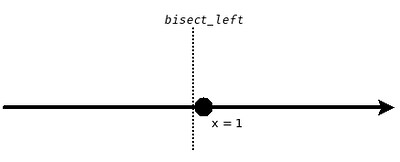Python: Binary Search / Bisection / Binary Search Tree (BST)
我先说下翻译的问题:
- bisection 是 “二等分” (指 action),bisector 是 “二等分线”,这俩其实是几何的概念,不管你怎么引申,回溯到几何是最好理解的
- bisection method 是 “二分法”,是一系列使用 bisection 思想的方法的统称
- binary search 是 “二分查找”,这么翻译也行吧,我觉得英文的问题更大一点,叫 bisection search 不好么?
- binary search tree (BST) 是 “二叉搜索树”,从 tree 的角度而言,叫 binary 是 OK 的
- 但是你 binary search 不能翻译成 “二叉搜索”,我们在搜索时没有 “叉” 这个动作
这一系列翻译我觉得最大的问题在 binary search,它应该叫 bisection search
1. Bisection in Geometry
几何学上的概念是简单的。比如我有一个 $x$-axis,或者直线 $(-\infty, +\infty)$,我在 $x=1$ 处切一刀,就做了一个 bisection,直线 $x=1$ 即是 bisector,如下图:

那在 python 有 bisect.bisect_left 和 bisect.bisect_right,为什么要分两个?它们有什么区别?
这是因为几何学不用考虑这个问题:$x=1$ 这个点,到底是属于左半边,还是右半边?(这肯定要涉及到度量) 但是你在实际应用中,比如我用在 array 上时,这个问题我必须要考虑。那这两个函数不严格地可以理解为:假设我在 $x=1$ 处有一个任意小的 neighborhood $\Phi(1, \epsilon)$,那么:
bisect.bisect_left(X, 1)就等价于 bisectXat the left boundary of (the neighborhood of)1- 那么 $x=1$ 这个点就属于右半边
bisect.bisect_right(X, 1)就等价于 bisectXat the right boundary of (the neighborhood of)1- 那么 $x=1$ 这个点就属于左半边


那从另外一个角度来说,如果直线上不存在 $x=1$ 这个点,比如说变成两条射线 $(-\infty, 1) \cup (1, +\infty)$,那么自然就不用管 $x=1$ 这个点的归属问题了。这个时候 bisect_left(X, 1) == bisect_right(X, 1):

2. Bisection in Python
bisect.bisect_left 和 bisect.bisect_right 主要用来切 sequence,当然前提是假设 sequence 是 sorted (like an $x$-axis)。
那假设我有一个 sorted sequence a,我想在 value x 处切割 a,那么你 bisect_left(a, x) 和 bisect_right(a, x) 返回的其实是 a 中的一个 index,这个 index 标志了 bisector 在 a 中的位置。
我把参考实现 cpython/Lib/bisect.py 稍微修改了一下,如下:
def bisect_left(a, x, lo=0, hi=None):
if lo < 0:
raise ValueError('lo must be non-negative')
if hi is None:
hi = len(a)
while lo < hi:
mid = (lo+hi)//2
if a[mid] < x: # ANCHOR
lo = mid+1
else:
hi = mid
return lo
def bisect_right(a, x, lo=0, hi=None):
if lo < 0:
raise ValueError('lo must be non-negative')
if hi is None:
hi = len(a)
while lo < hi:
mid = (lo+hi)//2
if a[mid] <= x: # ANCHOR
lo = mid+1
else:
hi = mid
return lo
有点搞笑的是这两个函数在 cpython/Lib/bisect.py 的注释是一样的:
Return the index where to insert item
xin lista, assumingais sorted.
这 TM 完全没有抓住重点,而且你还引入了 insert 这个新概念来解释,简直是添乱。
其实这两个函数就只有一行是不同的,就是在注释 # ANCHOR 的地方,一个是 < 一个是 <=。
2.1 When x in a
可以看出,当 x in a 的时候:
bisect_left的a[lo]会停靠在 first occurrence of== x,然后一直走else,让hi左移,往lo靠近bisect_right如果一直有a[mid] <= x,那么lo会一直右移,直到 first occurrence of> x,然后再是hi左移,往lo靠近
举个例子:
from bisect import bisect_left, bisect_right
a = [0, 1, 1, 1, 2]
i, j = bisect_left(a, 1), bisect_right(a, 1)
print(i, j)
# Output: 1 4
相当于就是:
a = [0, 1, 1, 1, 2]
^ ^
i j
那关于 slice 我们可以有一些结论。假设对同一个 x,i = bisect_left(a, x) 和 j = bisect_right(a, x):
- $\forall e \in$
a[:i], $e < x$ - $\forall e \in$
a[i:], $e \geq x$a[i] == x
- $\forall e \in$
a[:j], $e \leq x$ - $\forall e \in$
a[j:], $e > x$a[j] > x
- $\forall e \in$
a[i:j], $e = x$
那 list 有个操作叫 lst.insert(index, value) 是说把 value 放到 lst[index],然后后面的值全部往右 shift 一位。那么关于这个操作我们可以总结:
a.insert(i, ?)inserts just before the leftmostxa.insert(j, ?)inserts just after the rightmostx- 无论是
a.insert(i, 1)还是a.insert(j, 1)可以把1放置到正确的地方并保持asorted
# after a.insert(i, ?)
a = [0, ?, 1, 1, 1, 2]
^
i
# after a.insert(j, ?)
a = [0, 1, 1, 1, ?, 2]
^
j
然后有两个特殊情况要额外考虑一下:
a[0] == x然后做bisect_left(a, x)$\Rightarrow$ 会得到i == 0a[-1] == x然后做bisect_right(a, x)$\Rightarrow$ 会得到j == len(a)
from bisect import bisect_left, bisect_right
a = [0, 1, 1, 1, 2]
i = bisect_left(a, 0) # i == 0
j = bisect_right(a, 2) # j == 5
a = [0, 1, 1, 1, 2] _
^ ^
i j
2.2 When x not in a
当 x not in a 的时候, # ANCHOR 的两句,if a[mid] < x 和 if a[mid] <= x 都会跨越到 first occurrence of > x,所以此时这两个函数是相同的逻辑,偏 bisect_right 的风格:
from bisect import bisect_left, bisect_right
a = [0, 0, 0, 0, 22]
i, j = bisect_left(a, 1), bisect_right(a, 1)
print(i, j)
# Output: 4 4
相当于就是:
a = [0, 0, 0, 0, 22]
^^
ij
此时关于 slice 有:
- $\forall e \in$
a[:i], $e < x$ - $\forall e \in$
a[i:], $e > x$
关于 insert 有:
a.insert(i, 1)可以把1放置到正确的地方并保持asorted- insert 之后一般都会有
a[i-1] < a[i] == 1 < a[i+1](边界的特殊情况不考虑)
2.3 总结
无论我们有没有 x in a,我们似乎都可以说:
bisect_left(a, x)returns the index of the last occurrence of< xplus 1bisect_right(a, x)returns the index of the first occurrence of> x
3. Binary Search
代码完全可以从 bisect_left 或者 bisect_right 引申而来,只需要加一个 condition 也就是 if a[mid] == x 单独处理一下就可以了:
def binary_search(a, x, lo=0, hi=None):
if lo < 0:
raise ValueError('lo must be non-negative')
if hi is None:
hi = len(a)
while lo < hi:
mid = (lo+hi)//2
if a[mid] < x:
lo = mid+1
elif a[mid] == x: # ANCHOR
return mid
else:
hi = mid
return -1 # -1 is the error code if x not found in a
不同的实现,细节会不同,比如有初始化 hi = len(a) - 1 的,有 else: hi = mid - 1 的,这些都是边界的问题。我们这三个实现其实遵循了一个原则就是 lo 和 hi 组了一个半闭半开区间 [lo, hi):在执行 while lo < hi 的时候,这个区间一直是合法的;当你 lo == high 的时候, [lo, high) 这个区间就坍缩了,此时 while 就要结束了。你也可以理解为当 a[lo:hi] 这个 slice 如果为空的时候,while 结束。
关于这个三个函数我想强调的是:
bisectmodule 并没有 提供 binary search 的接口- 在强假设
x in a存在时,bisect_left(a, x)碰巧 返回的是 the index of the first occurence ofx,但它的逻辑 并不是 严格的 binary search
如果你坚持要用 bisect_left 来实现 binary search,可以这样:
from bisect import bisect_left
def binary_search(a, x):
i = bisect_left(a, x)
# bisect_left 不会 return -1
if a[i] != x:
return -1
return i
4. A Subtle Bug in Above Code
参 Extra, Extra - Read All About It: Nearly All Binary Searches and Mergesorts are Broken。
问题主要是在 mid = (lo+hi)//2 这句。极端情况,如果你的 hi == 2**31 - 1 达到你 32-bit machine 的 int 的上限,那么这个加法 lo + hi 会 overflow。
改进很巧妙:
mid = lo + (hi - lo) // 2
5. Binary Search Tree (BST)
TBD
留下评论